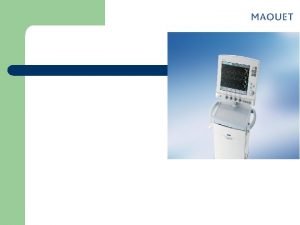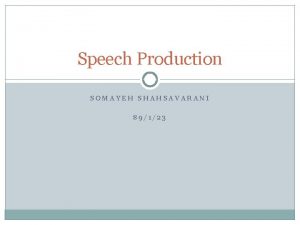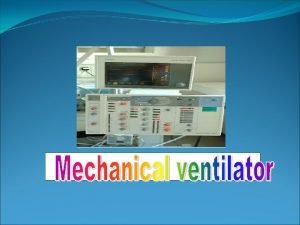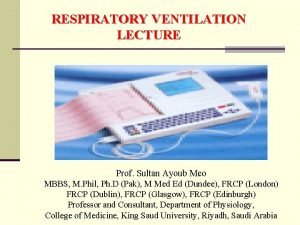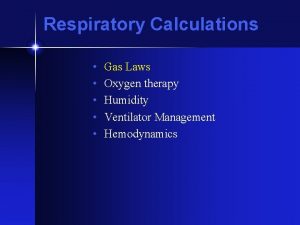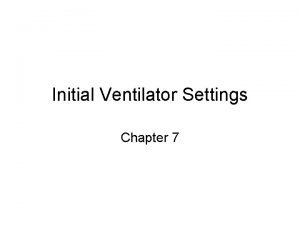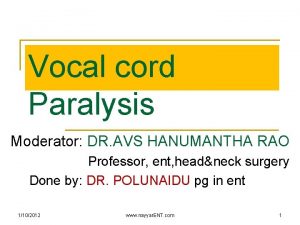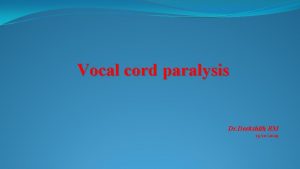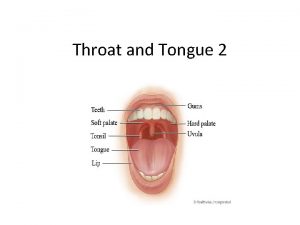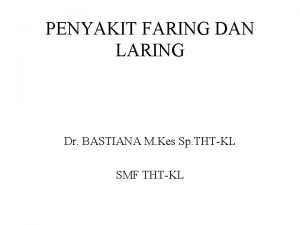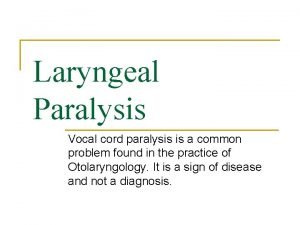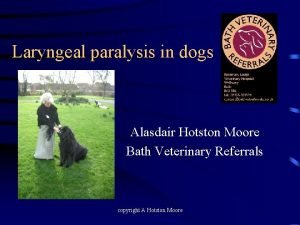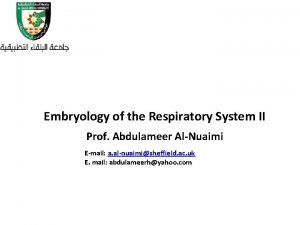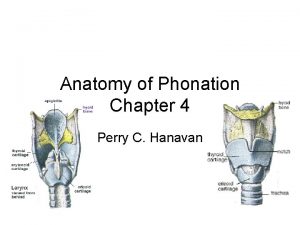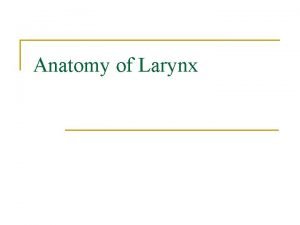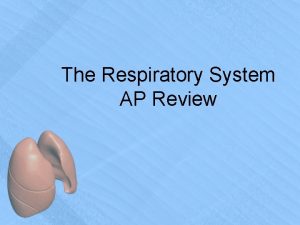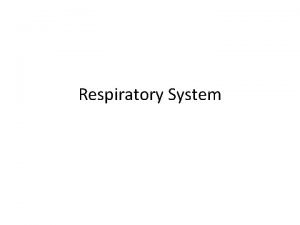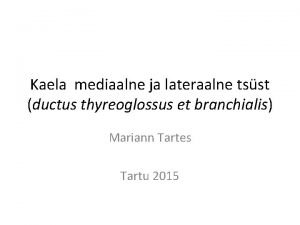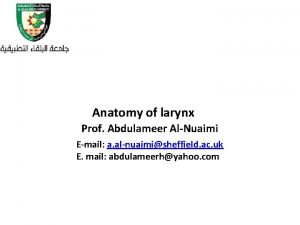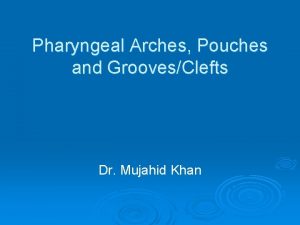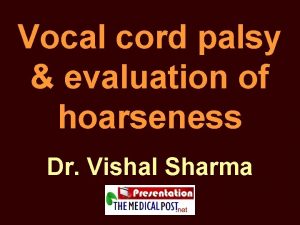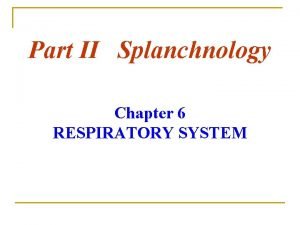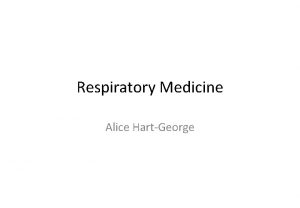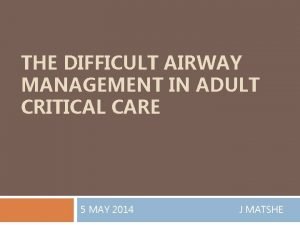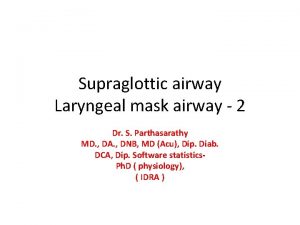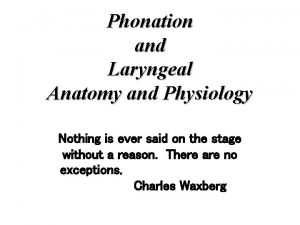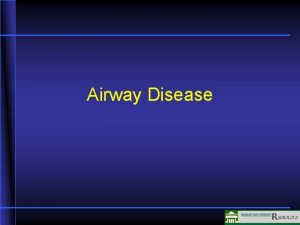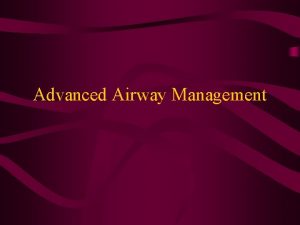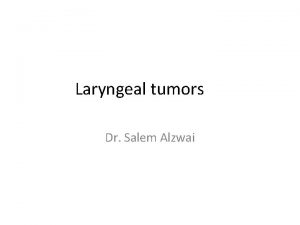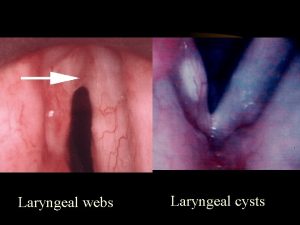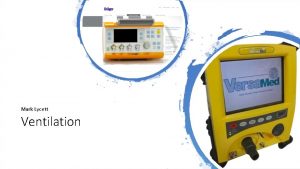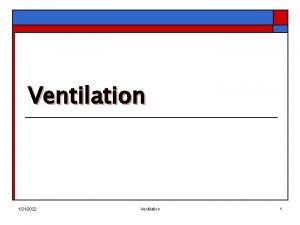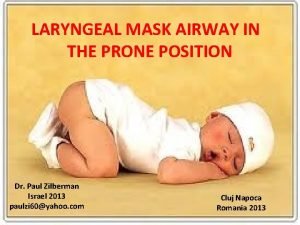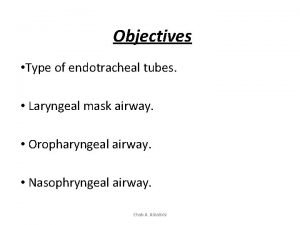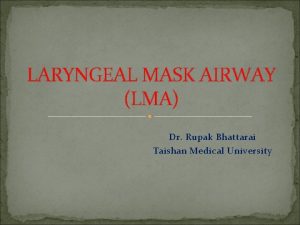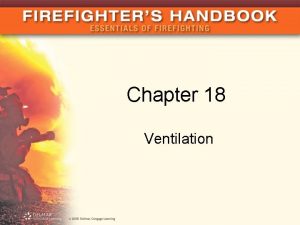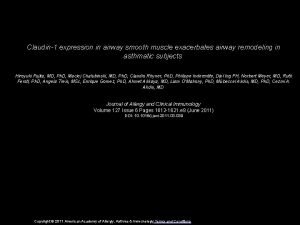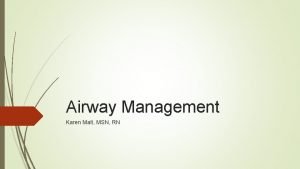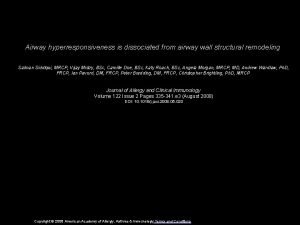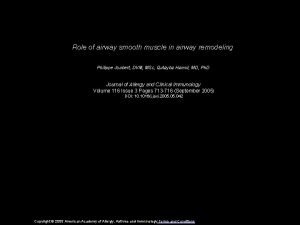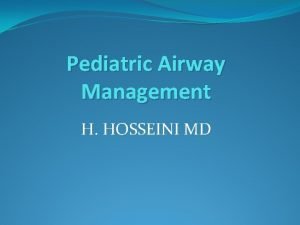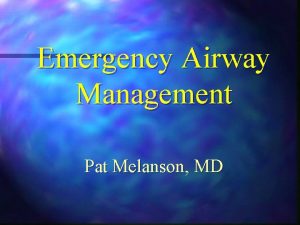INTRODUCTION Normal laryngeal functions are phonation ventilation airway





























- Slides: 29


INTRODUCTION Normal laryngeal functions are : • phonation, • ventilation, • airway protection. Failure of the laryngeal valve to achieve aerodigestive separation during swallowing results in aspiration.

LARYNGEAL ANATOMY & PHYSIOLOGY • The lower respiratory tract is protected from soilage by the glottis & other laryngeal protective mechanisms. Clearance of material, either aspirated or inhaled, is provided by mucous glands & cilia in the tracheobronchial tree that trap debris & move it to the glottis, to be expelled.

LARYNGEAL ANATOMY & PHYSIOLOGY The supraglottic larynx is designed to protect the laryngeal inlet by diverting the swallowed bolus laterally into the pyriform sinuses. The shield-like epiglottis, the aryepigottic folds & the lateral pharyngeal walls form “gutters” of the laryngopharynx, which direct the flow around the laryngeal introitus towards the posterior pharyngeal wall & postcricoid region. Reflex-coordinated relaxation of the cricopharyngeal sphincter & contraction of the constrictor muscles following laryngeal closure then move the bolus through the hypopharynx into the esophagus.

LARYNGEAL ANATOMY & PHYSIOLOGY • The laryngeal inlet, formed by the epiglottis, aryepiglottic folds, & arythenoids constitutes the first 1/3 of a sphincter system that reflexively close during normal swallowing. • The 2 nd 1/3 , at the level of the false V. C. • The true V. C. form the 3 rd 1/3 & most effective. . • The protective function of the larynx is predominantly reflexive & involuntary.

LARYNGEAL ANATOMY & PHYSIOLOGY • The afferent of sensory nerve fibers of the larynx travel in the internal branch of the SLN, providing ipsilateral innervation to the supraglottic structures. • Innervation below this level is provided by the ipsilateral RLN. • Afferent impulses pass up the vagus nerve to the nodose ganglion & from there to the tractus solitarius. • Efferent motor innervation of the larynx is mediated via the nucleus ambigus ( motor nucleus of X) for both reflex & voluntary functions. • The RLN innervates all intrinsic muscles of the larynx except the cricoithyroid muscle, which receives its innervation via the external branch of the SNL. • Innervation is unilateral except for the interarythenoid muscle, which receives bilateral input.

NORMAL SWALLOWING PHYSIOLOGY Oral Stage: is the initial act in swallowing. • Considered the only voluntary phase. • The tongue positions the bolus against the hard palate in preparation for the swallow. • These afferent impulses are carried by IX & X to the swallowing center located in the reticular formation of the medulla, which initiates the entirely reflexive: Pharyngeal stage: • As the bolus passes through the faucial arch, there is spontaneous & reflex elevation & approximation of the velum to the posterior pharyngeal wall.

NORMAL SWALLOWING PHYSIOLOGY Posterior movement of the tongue base & contraction of the suprahyoid musculature results in the laryngeal elevation which, in turn, displaces the epiglottis posteriorly, overlapping and protecting the glottis. As the peristaltic wave reaches the cricopharyngeal region there is reflex relaxation of the cricopharyngeal sphincter that facilitates passage of the bolus into the esophagus. Esophageal stage: primary peristaltic waves carry the bolus in an uninterrupted fashion throughout the entire esophagus. Secondarily , peristaltic waves may be initiated anywhere in the esophagus where residual food may be present.

PHYSIOLOGY OF COUGH • The development of a cough requires an intact sensorineural glottic apparatus. • Begins with a sudden deep inspiration through the widely patent glottis. Next forceful contraction of the expiratory muscles of respiration against the closed glottis results in rapid increase in intrathoracic pressure. The cough is concluded with the reflex opening of the glottis, producing an explosive flow of air.

PATHOPHYSIOLOGY OF ASPIRATION 1 -Local structural abnormality: • Tumor involving the tongue base, hypopharynx, supraglottic , & glottis may be associated with aspiration. Because of infiltration, mass effect, or pain. • Similarly , aspiration is commonly encountered on the postoperative head & neck surgical unit, especially surgery of the mobile tongue if the bolus is inadequately prepared & moved into. 2 -Neurologic defects: • multiple cranial neuropathies, brain-stem insults, or neuropathy which develops in the setting of chronic cachexia… • injury to the RLN nerve is commonly encountered---> paralysis of the ipsilateral VC in the paramedian position. • Injury to the SLN --> paralysis of the cricopharyngeal muscle & anesthesia of the ipsilateral supraglottic larynx.

PATHOPHYSIOLOGY OF ASPIRATION • Incidence: 10 -20% aspirate of patients with GERD or achalasia. • 69% of tracheotomized patients. • Silent aspiration in 7% of a large series of routine anesthetics. • 40% of patients with ET will ( 20% if low pressure), Predisposing conditions: • reduced level of consciousness, • dysphagia, • anatomic derangements of normal respiratory & swallowing reflexes. . • NG tube.

TREATING ASPIRATION • Nursing, rehabilitative maneuvers, • Surgery: tracheostomy, Cricopharyngeal myotomy (CPM), Laryngeal suspension, Partial cricoid resection, Laryngeal stenting, Vocal-Cord medialization, Total laryngectomy, Laryngeal closure: -Glottic closure, -Supraglottic closure, -Subglottic closure.

Quiz The initial management of an ambulatory aspirating patient should include: a-partial cricoid resection. b-tracheostomy. c-Instruction in supraglottic swallowing techniques

Quiz Chronic, intractable life-threatening aspiration in a neurologically impaired patient is best managed by: a-supraglottic separation b-cricopharyngeal myotomy. c-Total laryngectomy. d-laryngotracheal separation.

Quiz 50 y. o. male patient is going to underwent an ablative head-and-neck surgery. What is the best technique to avoid future aspiration: a-glottic closure. b-laryngeal stenting. c-Vocal cord medialization. d-laryngeal suspension.

Nursing, rehabilitative maneuvers • retraining of the swallow employs the so-called supraglottic swallowing technique. It assumes that food particles & liquids are retained in the pharynx above the glottis after a swallow & must be expelled or swallowed again prior to inspiration. • Unfortunately, this technique does not prevent aspiration universally even in highly motivated patients, & may not be applicable in patients with underlying respiratory insufficiency or ineffectual cough.

Nursing, rehabilitative maneuvers • Solids are often avoided because of the need for mastication & the potential for the life-threatening aspiration of unchewed food. It is important to recognize, however, that the potential to aspirate is higher with thin liquids. • Accordingly , the use of nonpourable pureed foods is ideal in the management of many patients. • Upright position may reduce aspiration through reduction of GER.

SURGICAL TREATMENT • should be effective but as noninvasive as possible. • No single procedure is perfect for all patients, so multiple approaches have been developed. • The presence of tracheotomy does not control aspiration, & there is potential for exacerbating the condition. It does however facilitate nursing care, suctioning. . .

CRICOPHARYNGEAL MYOTOMY (CPM) • Performance of CPM presumes that aspiration is caused by or aggravated by slow or failed. Reflex relaxation of the cricopharyngeal muscle during the pharyngeal plane of swallowing. • Through a lateral cervical approach. The actual myotomy is done near the midline posteriorly. • It would be prudent to perform the procedure on the side of preexisting RLN injury. The muscle fibers of the inferior constrictor, cricopharyngeus muscle, & upper fibers of the esophageal sphincter are incised for a vertical distance of 4 -6 cm.

LARYNGEAL SUSPENSION • Laryngeal suspension is usually performed as part of the primary surgical procedure during ablative head-&-neck surgery. Failure of elevation leaves the laryngeal inlet exposed during the pharyngeal phase of swallowing. When combined with inadequate or absent epiglottic rotation and laryngeal closure, the patient is at significant risk for aspiration. • Nonabsorbable suture placed from the mandible to the hyoid bone or thyroid lamina. A lateral suspension technique that further increased th pharyngeal opening and laryngeal protection was reported by Hillel & Goode.

PARTIAL CRICOID RESECTION • following head & neck ablative surgery. • Phonation is preserved by the procedure but a permanent tracheostomy is required. • A subtotal resection of the postero-inferior one half of the cricoid cartilage is performed together with a CPM. • The cricoarythenoid joints and the posterior cricoarythenoid muscle & its nerve supply are left undisturbed.

LARYNGEAL STENTING • In severe laryngeal trauma. • The Rliachar stent is hollow & can be modified to permit vocalization through a one-way valve. • Best suited for short-term utilization.

VOCAL CORD MEDIALIZATION • Patients who have suffered unilateral vocal-cord paralysis that results in symptomatic aspiration may be good candidates for a variety of vocal cord augmentation or medialization procedures. A variety exist: • Advantage of Awake v/s GA procedure: the surgeon can judge the degree of medialization. • The material is injected lateral to the thyroarythenoid muscle, between the vocal process and thyroid cartilage in the middle & posterior 2/3 of the true cord. Overinjection should be avoided.

VOCAL CORD MEDIALIZATION • Control of severe aspiration by vocal cord medialization is not likely, however, when it occurs in conjuction with an insensate larynx. More definitive separation of the upper airway from the digestive tract may be required in these patients.

TOTAL LARYNGECTOMY • for much of this century, TL has been the procedure of choice. Still indicated in patients with poor prognoses. • A narrow-field procedure, as described by Blitzer et al can be performed. In this technique the strap muscles are preserved, the mucosa over the arythenoid & cricoid is preserved to minimize tension on the closure.

GLOTTIC CLOSURE • first described by Montgomery in 1975, • may be performed through a midline thyrotomy. The mucosa of the true & false cords are stripped & sutured together. • The potential for permanent laryngeal stenosis make this procedure less than ideal if reversibility is feasible. • Unreliable in the presence of mobile vocal cords. • Normal speech is sacrified.

SUPRAGLOTTIC CLOSURE • the mucosal edge of the epiglottis, arytenoids & aryepiglottic folds are denuded then sutured together through an infrahyoid pharyngectomy. A small posterior dehiscence may act as a one-way valve, allowing phonation but not aspiration!!! • Tracheostomy is required. • A potential risk for aspiration persists.

SUBGLOTTIC CLOSURE • eliminate aspiration without altering the glottis & the supraglottis. • 2 variations: trache-osophageal diversion (TED), & the laryngo-tracheal separation (LTS). • Aspirated material is diverted from the trachea back into the esophagus. The presence of a previously placed high tracheostomy was found to preclude a tracheoesophageal anastomosis. Therefore, the standard Lindeman procedure was modified by oversewing the proximal trachea as a blind pouch.

SUBGLOTTIC CLOSURE • Tracheoesophageal diversion & laryngotracheal separation are as efficacious as total laryngectomy in controlling aspiration. • Decrease requirement for intensive skilled nursing care. • The reversibility of the procedure is well documented.
 Mikael ferm
Mikael ferm Airway grade view
Airway grade view Aprv
Aprv Arytnoids
Arytnoids Phonation and articulation
Phonation and articulation Phonation and articulation
Phonation and articulation Mechanical ventilation modes
Mechanical ventilation modes Minute ventilation normal
Minute ventilation normal Desired fio2 formula
Desired fio2 formula Normal minute ventilation
Normal minute ventilation Unilateral superior laryngeal nerve injury
Unilateral superior laryngeal nerve injury Thyroplasty types
Thyroplasty types Intrinsic laryngeal muscle
Intrinsic laryngeal muscle Arytenoid muscle
Arytenoid muscle Odinofoni adalah
Odinofoni adalah Vocal cord palsy
Vocal cord palsy Alternatives to surgery for laryngeal paralysis in dogs
Alternatives to surgery for laryngeal paralysis in dogs Photo search
Photo search Relaxor of vocal cord
Relaxor of vocal cord Intrinsic laryngeal muscle
Intrinsic laryngeal muscle Laryngeal inlet
Laryngeal inlet Lobar bronchus
Lobar bronchus Laryngeal prominence
Laryngeal prominence Conus elasticus
Conus elasticus Coarcotation
Coarcotation Pharyngeal arch
Pharyngeal arch Thyrocricoidectomy
Thyrocricoidectomy Conus elasticus larynx
Conus elasticus larynx Types of respiratory failure
Types of respiratory failure Thyromental distance fingers
Thyromental distance fingers


